Sol: различия между версиями
>Tablespoon (→Luna) |
>Tablespoon |
||
| Строка 28: | Строка 28: | ||
===Earth (Sol III)=== | ===Earth (Sol III)=== | ||
[[Image:Earth(2456).jpg|thumb|250px|Earth is the homeworld of humanity and was once home to millions of species. It has since suffered ecological devastation.]] | [[Image:Earth(2456).jpg|thumb|250px|Earth is the homeworld of humanity and was once home to millions of species. It has since suffered ecological devastation after being bombarded from orbit a century ago.]] | ||
[[Image:Earth_ruins.jpg|thumb|600px|A rare photograph of the remains of Stuttgart, Germany in the European Habitable Zone. This region is governed by a centuries old rump state of the German government, which has persisted in spite of near-total destruction of Earth.]] | |||
'''Development level''': Low; Ecological and Societal Ruins; Kessler Syndrome prevents orbital development | '''Development level''': Low; Ecological and Societal Ruins; Kessler Syndrome prevents orbital development | ||
Версия от 07:37, 2 декабря 2014
System Information
Member of Sol Alliance
Region: Central Administration Zone (CAZ); Center of Inner Colonies
Settled Planets/Planetoids: 3
Overall Development Level: Medium
Total Population (est.): 5,718,000,000 - 5,968,000,000
Military Presence: Heavy
Points of Interest: New Concordia Station, Aries Martian Shipyards, Aishwarya Lunar Recreation Arcology, Sol Alliance Civil War Memorials, Earth Preservation Zones
Sol is a stable G-class main-sequence yellow dwarf star classified in the spectral class of G2. It more than 4.5 billion years old, and has eight planets in orbit around it, as well as an asteroid belt, a rocky dwarf planet and a cloud of icy comets. Sol is the home system of Humanity, and Earth is their homeworld.
Most standardized systems of cosmic measurement and timekeeping are based upon the day/night cycle and astronomy visible from Earth. Earth and three other planets in orbit around Sol are rocky and rich in resources, and the remaining four planets are gas giants.
Planets and Major Bodies
Mercury (Sol I)
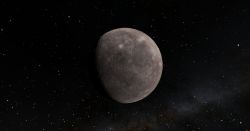
Mercury is the nearest planet in orbit around Sol. It orbits Sol at a periapsis of 0.38 AU and an apoapsis of 0.39 AU. It completes one full revolution around its parent star every 88 standard days, and has a day that is a little more than 58.6 standard days long. It is a small terrestrial planet, being smaller than Earth’s moon. It’s surface is pitted with craters from eons of meteor impacts. The planet has a very thin exosphere composed of mainly oxygen, though it it much too thin to sustain any form of life. Mercury experiences wild variation in terms of surface temperature, with its daytime side reaching temperatures of 430 °C, and the night side dropping to the range of -180 °C. The planet faces constant bombardment from small meteors and solar wind, with no atmosphere thick enough to prevent it. No attempts were ever made to colonize the planet due to its utter lack of resources and extreme conditions. Civilian travel is not advised.
Venus (Sol II)
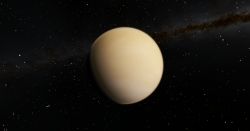
Venus is the second terrestrial planet in the Sol system. It orbits Sol at an average distance of 0.72 AU. A Venusian year lasts 225 standard days, while a Venusian day is longer, at 243 standard days. Venus spins retrograde when compared to the other planets in the Sol system, causing the sun to rise in the west and set in the east in its sky. Venus has an extremely thick and toxic atmosphere, composed of large amounts of carbon dioxide and nitrogen. The rain that falls upon the surface is composed of sulfuric acid. Because of how thick the planet’s atmosphere is, a runaway greenhouse effect has made the planet uninhabitable to all life. The atmosphere is so thick that it exerts massive amounts of pressure on the surface, which has crushed all but the most structurally reinforced of scientific equipment sent to study the planet, while the rest was destroyed by caustic acid rain. The planet hosts massive amounts of volcanic activity, which spew more toxic gases into the atmosphere. Almost no sunlight reaches the surface of the planet, yet temperatures exceed 480 °C. No attempt has ever been made to colonize the planet due to extreme conditions. Civilian travel is not advised.
Earth (Sol III)
Development level: Low; Ecological and Societal Ruins; Kessler Syndrome prevents orbital development
Capital: None
Terrestrial Population (est.): 750,000,000 - 1,000,000,000
Spacer Population (est.): 40,000 members of orbital blockade, mostly based on Luna
Earth is the third planet out from Sol. Today, Earth is considered little more than an irrelevant backwater by a majority of humanity. Earth was originally a Garden world, harboring millions of unique species of flora and fauna. It possessed extremely diverse ecosystems, with huge deserts, sprawling tundra, massive mountain ranges, rolling grasslands, and thick swaths of tropical rain forest. 71% of the Earth’s surface was covered in salt water, although massive lakes of fresh water within continental areas. It was a temperate world before it was devastated by Kinetic Kill Vehicles (KKVs). In the modern age, Earth is mostly uninhabitable, with only a few areas having been terraformed and shielded from the rest of the irradiated geosphere.
As humanity's homeworld, Earth bore witness to tens of thousands of years of human history and development, from the harnessing of fire and simple tools to humanity's rapid colonization of the stars. As the planet entered the 20th and 21st centuries, it's ecology suffered as a result of haphazard development, industrial accidents and population booms. As natural resources dried up, humanity was forced into the stars. Overtime, Earth came to consume a massive amount of extrasolar resources in order to support it's billion of citizens.
Earth's demise came during the second Sol Alliance civil war, when KKVs were fired on the planet is retaliation of attacks against the Inner colonies. In an instant, entire landmasses were leveled, flora and fauna were vaporized and billions of people were obliterated.
Today, Earth is home to between 750 million and a billion humans (although the exact number is extremely difficult to determine), living in advanced 'preservation domes', underground disaster shelters and on the few surfaces still able to support some degree of life. The planet suffers from Kessler's Syndrome, making orbital development nearly impossible. The Alliance maintains a blockade around the planet, regulating a steady stream of supplies and aid to some settlements. The blockade maintains an emigration quota, allowing only 10,000 individuals a year to legally leave the planet. Travel to the planet, outside of military channels, is tightly controlled, but a lucrative (and dangerous) business of smuggling has been steadily growing.
Earth has one moon, Luna, which managed to avoid most of the damage dealt to Earth.
Luna
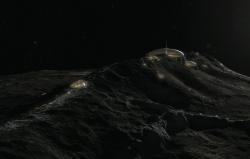
Development level: Medium; Advanced, interconnected Biodomed Cities; Pocketed with shoddily constructed Earth-slums
Capital: Harmony City
Terrestrial Population (est.): 373,674,843
Spacer Population (est.): 162,981
Noteworthy places: Lunar University of Medical Science
Luna is the moon of Earth. It is tidally locked to its parent and makes a complete revolution every 28 standard days. It formed when a rogue planetoid collided with Earth during the early stages of its formation. The moon came together from the resultant orbital debris. Luna was the first target of spacefaring humans as they pierced the outer layers of the atmosphere. It was largely ignored until the age of FTL travel and colonization, when small colonies were established, mostly as refueling and launching posts for re-entry craft.
Luna is something of a mishmash of human society. Prior to Earth's destruction, Luna was developed into an off-world hub for Earth trade and even boasted a large Resort hub. Surviving the second Sol Alliance Civil War relatively intact, Luna immediately saw an influx of refugees from Earth. The pristine, advanced biodomed cities became dotted with hastily constructed slums. Luna's economy is based around Earth orbital salvage operations, tourism and supporting the Alliance Earth Blockade. Tensions exist between the original inhabitants and the refugees, leading to the biodomes being divided up between rich and poor through the use of massive intra-dome walls. Harmony City and Heng Chang Commune have suffered multiple riots between economic classes.
Luna, being directly administered by the Alliance, democratically elects it's leaders; however, due to social tensions, the military has taken over the job of local police and some areas remain under indefinite marshal law.
Luna also houses a number of human cultural artifacts rescued from Earth, including a significant portion of The Lourve's collection.
Mars (Sol IV)
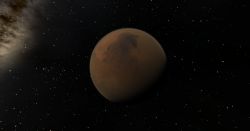
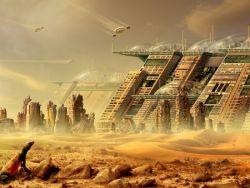
Development level: Medium-High; Pockets of Open Metropolises, Biodomes, Large Space Stations, Developed Infrastructure, Cramped Slums
Capitals: Olympia (planetside); New/Nova Concordia Station (orbital)
Terrestrial Population (est.): 4,592,943,380
Spacer Population (est.): 1,372,248
Mars is the fourth planet out from Sol. It orbits Sol at approximately 1.52 AU. A Martian day is only slightly longer than a standard day at 25 standard hours, but the Martian year is 687 standard days long. It is the outermost terrestrial planet in the Sol system. It is known as the Red Planet, because the iron-rich dust that covers most of the planet’s surface gives it a reddish tinge that was visible to the naked eyes of astronomers on Earth in ancient times. Mars has a relatively thin atmosphere.
Mars was a target of one of the first bodies colonized by humanity. It's population swelled in the early days of the Second Space Race as prospectors sought to claim their fortune mining the planet to satisfy Earth's ever-growing need for raw materials. It's population reached a peak in the 2200's when one of humanity's first global terraforming efforts backfired, killing millions as decades of steady environmental changes were undone in seconds. Mars has slowly been recovering since then, but has never quite been able to shake the reputation of being a 'massive failed project'.
Suffering extensive damage as a result of the Second Sol Alliance Civil War, Mars was the fortunate recipient of human aid. Small scale terraforming projects allowed for limited zones of habitability within the largest craters. These small pockets saw a boom in development, as people migrated from centuries old biodomes into newly constructed open cities. As with Luna, Mars was flooded with Earth-refugees, who largely took over the old bio domes. In spite of a civil construction surge, housing is a constant problem, as the open cities struggle to support any additional development and those living in the biodomes are subject to cramped spaces and inadequate basic services.
Overall, Mars maintains the highest quality of life in the Sol system, prompting some to call for full, planetary terraforming efforts to turn the planet into a 'New Earth'. However, along with it's housing problems, Mars is riddled with ruins as a result of the Alliance Civil War, which has rendered some areas uninhabitable or even radioactive. There are ongoing efforts to undo this damage by Alliance, local government and private interests, but most estimates claim that Reclamation efforts will take 30 years at least. It is also estimated that at least 10% of the planet's nearly 600 million residents are surviving in various ruins in deplorable conditions far worse than those in the most overcrowded biodome.
Mars' economy is developed and mixed, with it's largest industries being orbital construction, mining, salvaging and a small but rapidly growing hydroponics industry. Mars also enjoys being the center of Sol trade, with over 90% of Sol's trade at some point passing through the planet or one of it's stations, due in no small part to the Memorial Warp Gate near the planet.
The planetary capital of Mars is Olympia, located within the Galle Crater Terraformed Zone, but a majority of senior administration facilities and personnel reside in orbit on New Concordia station along with the highest echelons of Sol Alliance leadership and bureaucracy.
The Asteroid Belt
Development level: Low-Medium; Extensive Mining Operations
Capital: None; Under direct jurisdiction of Sol Alliance
Terrestrial (Asteroid) Population (est.): 4,788,382
Spacer Population (est.): 5,165,986
The Asteroid Belt is an area around Sol where thousands of rocky bodies, too small to be called planets or even dwarf planets, orbit. The zone encompasses an area between 2.2 AU and 3.2 AU away from Sol. The asteroids in the belt are rich in precious and semi-precious metals, hydrogen and water. The density of asteroids in the zone is relatively low, which was an important factor in allowing asteroid mining companies to establish footholds. The oldest and largest of these asteroid mining companies is the Beltway Mining Company, which has claimed the rights to mine most of the Asteroid Belt. Other fledgeling companies have often been pushed out through strategic economic maneuvers, intimidation, and sometimes force. Beltway has a main base located on the planetoid Ceres, the largest body in the asteroid belt. Over the years, the planetoid has been hollowed out by intensive mining operations, and now serves as a massive complex that the rest of their operations are based out of.
Jupiter (Sol V)
Terrestrial (Moons) Population (est.): 192,465
Spacer Population (est.): 4,687
Jupiter is the fifth planet out from Sol. It is the largest gas giant in the system and is actually two times larger than all the other planets of the Solar system combined. It is composed of Helium and Hydrogen in similar ratios as Sol itself, suggesting that Jupiter may have been on the road to becoming a dwarf star, but never achieved the mass to ignite. Jupiter orbits Sol at distance ranging from a periapsis of 4.951 AU to an apoapsis of 5.455 AU. A Jovian day lasts approximately 10 standard hours, while a Jovian year is almost 11.9 standard years long. Jupiter is known for the multicolored bands and massive storms that are visible on the top of the planet’s atmosphere. The most well-known feature of Jupiter is its Great Red Spot, a massive hurricane many times the size of Earth that has been raging for centuries. Jupiter has more than 67 moons in total, though only the Galilean moons (Europa, Ganymede, Io, Callisto) are home to outposts that serve more as tourist destinations than actual military installations. Jupiter itself is uninhabitable, due to the superdense atmosphere and high gravity crushing anything that even attempts to enter the planet's atmosphere. Jupiter is the second largest source of tourism for the Solar system.
Saturn (Sol VI)
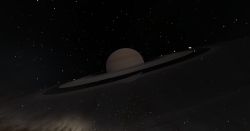
Terrestrial (Titan) Population (est.): 2,348
Spacer Population (est.): 48,994
Saturn is the sixth planet of Sol, and the second largest gas giant in the system. It is known for the spectacular systems of rings that encircle the planet. It is the second largest gas giant in the system, with a composition similar to Jupiter. It orbits Sol at a distance ranging from 9.023 AU at the periapsis, to 10.050 AU at the apoapsis. A day on Saturn lasts approximately 10.7 standard hours, while it takes almost 29 standard years for it to complete one full revolution around Sol. Saturn has more than 62 moons, but only the largest, Titan, is inhabited. Titan is home to a small tourist complex and colony of 2,348 people. With its hundreds of brilliant rings, Saturn is a major tourist attraction within the Solar system.
Uranus (Sol VII)
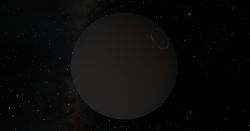
Uranus is the seventh planet of Sol. It is an ice giant that is tilted on its side so that its equator is at a right angle to its orbit. A day on Uranus lasts approximately 17 standard hours, while its orbital period is approximately 84 standard years long. It orbits Sol with a perapsis of 18.28 AU and an apoapsis of 20.10 AU. The planet has 27 moons, although none of them are inhabited. The planet’s striking blue color is attributed to the high amounts of methane present in the atmosphere, as well as the methane ice crystals and ammonia that makes up the slushy “mantle” of the planet. It has several faint rings around it.
Neptune (Sol VIII)
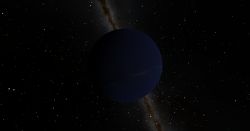
Neptune is the eighth planet of Sol, and the sister ice giant to Uranus. It has a very similar composition, with high amounts of methane present in the atmosphere. Large amounts of water are also present in the planet’s mantle. A Neptunian day lasts approximately 16 standard hours, while a Neptunian year is 165 standard years long. It orbits Sol at a distance ranging from 29.81 AU, to 30.33 AU. Neptune has 17 moons. Triton, the largest, had an active outpost on it at one point in history, but it was abandoned several hundred years ago.
The Kuiper Belt
The Kuiper Belt is the region beyond the orbit of Neptune that is home to tens of thousands of icy bodies, and potentially hundreds of thousands more. The Kuiper Belt encompasses an area from 30 AU to 55 AU away from Sol. Of the icy bodies present in the belt, Pluto and Eris are the most well known. The icy bodies here are rich in hydrogen and water, but lacking in terms of other resources, such as metals. The Kuiper Belt may also be home to up billions of comets too small to be detected.
The Oort Cloud
The Oort Cloud is a spherical area of space that encases the Sol system. It begins where the Kuiper Belt ends, and extends outward until almost 1.5 LY away from Sol. It is estimated that Oort Cloud may contain up to a trillion icy bodies, including planetoids and comets. Unlike the Romanovich Cloud of Tau Ceti, the bodies in the Oort cloud are metal-deficient, making the effort of locating bodies in this region to mine a pointless endeavour.